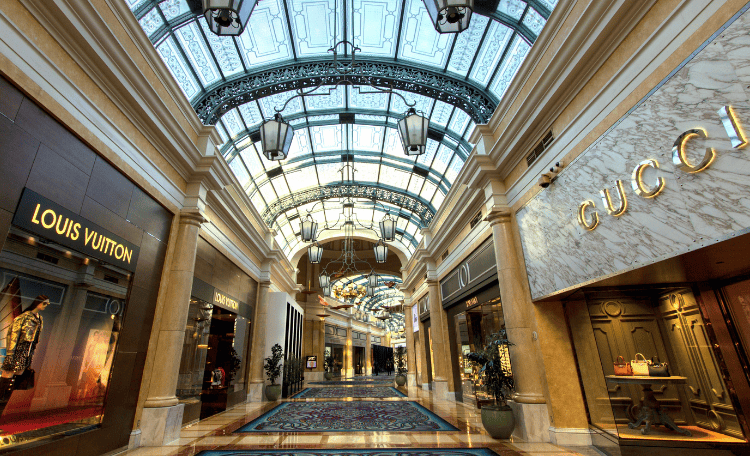Floor markings and regulated number of customers in shops will ensure greater safety.
Shopping centres in excess of 5,000 square metres1 opened to customers again on 11 May following almost two months of closure and much discussion and arguing. How did their appearance and operation change with a view to ensuring greater safety? What restrictions do customers experience? Is there any reason to be worried about visiting a shopping centre? Cushman & Wakefield prepared 17 shopping centres under its management for reopening and offers a set of measures that will significantly improve safety for customers.
Those who are going to visit a shopping centre in the next few days should expect it to look and work somewhat differently from what we were used to previously. In accordance with the requirements defined by the government, the owners and managers of the retail schemes are adopting measures geared towards protecting visitors from COVID-19 infection, and this may affect their convenience somewhat.
Ondřej Fukal, Partner & Head of Asset Services CZ & SK, Cushman & Wakefield, said: “The measures are not radically different from those that we are already used to in other environments – on public transport, in shops that are open and in offices that are operating again. People realise how important the measures are and observe them, so we believe they will accept them in shopping centres as well and will not be discouraged from getting back to their usual shopping habits.”
Six Feet Retail concept for better safety
The system of measures that Cushman & Wakefield launched in the shopping centres under its management and that can inspire other operators is based on the Six Feet Retail concept. Following offices that have used the Six Feet Office concept for their reopening, retail is the second sector where the speed of recovery relies on a concept that works, among other ideas, with the safe distance of six feet.
For shopping centres, the key is in three groups of measures detailed in a manual intended for shopping centre managers: sanitation and safety, social distancing and information.
Sanitation: Increased frequency of cleaning and sanitation in all areas of the shopping centre and providing sanitisers to customers are a matter of course. After all, this is also what the government ordinance requires in line with regional sanitary authority’s instructions. The manual provides details and suggests certain other measures that can be adopted.
Social distancing: Keeping a safe distance between shoppers is made easier thanks to signage, primarily on the floor. It indicates the six feet distance in areas where people can gather. Tenants are also recommended to regulate the number of customers who can shop in their units at one time.
Information: Knowing the rules of safe behaviour is part and parcel of successful operation under the new conditions. Information racks and signs placed on the premises and regular voice announcements remind the customers of the measures they are supposed to observe in order to improve their own safety and the safety of others, and a specially trained coordinator oversees everything. It is also crucial to reassure the visitors that the shopping centre is doing its best for their safety and that they feel comfortable. To that end, stickers appear at the entrance to the centre and to the individual shops whereby Cushman & Wakefield confirms that certain parameters have been satisfied and that there is nothing to worry about.
Preparations for opening: professional and in a record-breaking time
The government’s decision to open shopping centres arrived earlier than initially announced. This is definitely a positive move from the viewpoint of centre tenants and owners as well as in terms of economic recovery. However, it placed high demand on the preparation of the shopping centres.
Ondřej Fukal, Partner & Head of Asset Services CZ & SK, Cushman & Wakefield, said: “In a matter of one week, we had to complete a number of steps that are crucial for the opening. Some were clearly defined by the government; for others, we drew inspiration from our international colleagues – for instance, in Spain, Italy, Poland and the Netherlands where our company has also prepared plans and manuals for the opening of shopping centres. Thanks to our international background, we were able to prepare the centres so that they will ensure full safety and comfort for customers.”
The government requirements say, for example, that employees must be trained with regard to the infection and protection from it. Cushman & Wakefield’s shopping centre management experts rapidly prepared an online course that the employees took, thus obtaining the required training certificate.
Other required measures include providing sanitisers to customers, which should be addressed with attention to the minutest detail – including the aesthetic aspect – in professionally managed shopping centres.
It is also vital to pay attention to the appearance of the signage (e.g., for social distancing) – it has to be clear and comprehensible for customers – which is where consistency helps. A well-managed shopping centre will use signage aligned with its visual identity. The overall results appear professional and easy to navigate.
The production of all elements had to be organised in a record-breaking time, as had their installation, the great part of which was done during last weekend so that everything was ready for the arrival of the first customers on Monday.
The best feeling in shopping centres
All measures are also continuously coordinated with the individual tenants they also concern. The shared goal is to ensure that customers feel really good in the shopping centres, that a visit is a pleasant experience for them despite the restrictions and that they start using the facilities frequently again.
Jak Kotrbáček, Partner & Head of CEE Retail Agency Team, Cushman & Wakefield, said: “The 300 million customers who visit shopping centres in the Czech Republic every year represent a significant figure. It is key to attract those customers back to the shopping centres with a view to keeping the retailers afloat and restarting the economy. To that end, our teams of more than 50 retail and property management experts have worked hard over the past few weeks and days to create the prerequisites that will allow customers to return to shops and feel completely safe there. Over the course of one week, we transformed 15 per cent of Czech shopping centres into safe zones.
I hope that the other retail scheme owners and managers in the Czech Republic will prepare their assets so as to make shopping an experience that is safe and as pleasant as possible while respecting the tightest sanitary and technical requirements. I believe that customers will respect the changes because cooperation and mutual understanding between customers, retailers and scheme owners is key. Without it, even the best measures cannot work well, and forced repression is not an option. Hence, we would like to thank everyone for their cooperation and understanding, through which customers will boost the recovery of the economy.”
1 There are currently 107 shopping centres with an area in excess of 5,000 sq m in the Czech Republic and their floor area exceeds 2.5 million sq m. Cushman & Wakefield manages 17 shopping centres with a total floor area more than 300,000 sq m in the Czech Republic.

